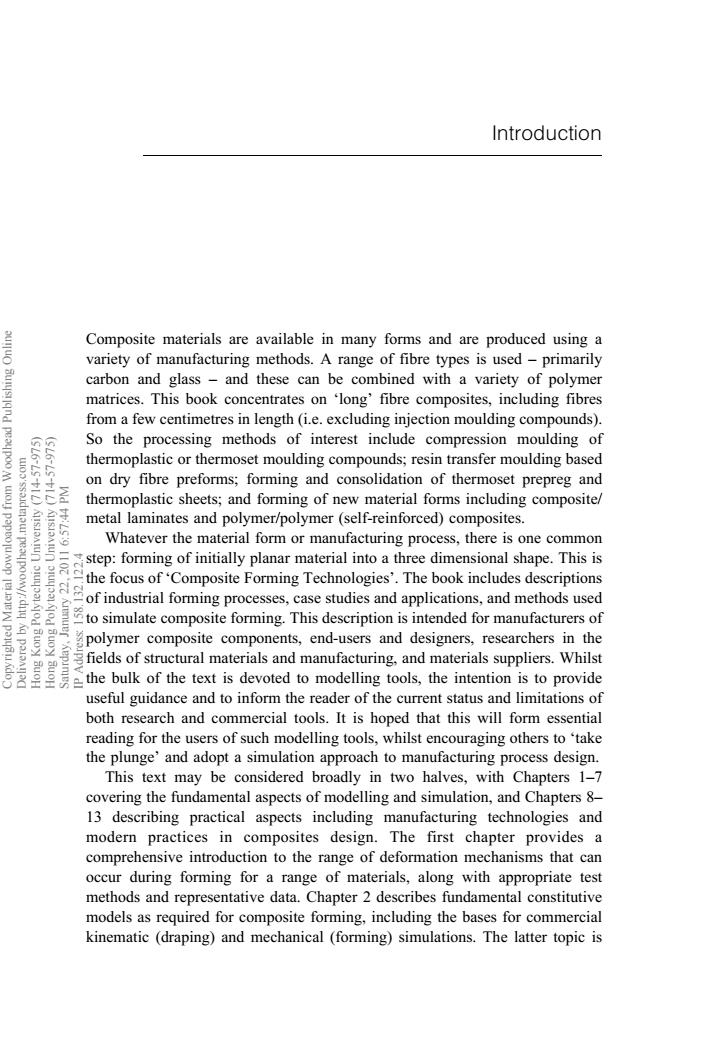正在加载图片...

Introduction Composite materials are available in many forms and are produced using a variety of manufacturing methods.A range of fibre types is used-primarily carbon and glass -and these can be combined with a variety of polymer matrices.This book concentrates on 'long'fibre composites,including fibres from a few centimetres in length(i.e.excluding injection moulding compounds). So the processing methods of interest include compression moulding of poo M thermoplastic or thermoset moulding compounds;resin transfer moulding based on dry fibre preforms;forming and consolidation of thermoset prepreg and thermoplastic sheets;and forming of new material forms including composite/ 759 metal laminates and polymer/polymer(self-reinforced)composites. Whatever the material form or manufacturing process,there is one common step:forming of initially planar material into a three dimensional shape.This is the focus ofComposite Forming Technologies'The book includes descriptions of industrial forming processes,case studies and applications,and methods used 四 to simulate composite forming.This description is intended for manufacturers of polymer composite components,end-users and designers,researchers in the fields of structural materials and manufacturing,and materials suppliers.Whilst the bulk of the text is devoted to modelling tools,the intention is to provide useful guidance and to inform the reader of the current status and limitations of both research and commercial tools.It is hoped that this will form essential reading for the users of such modelling tools,whilst encouraging others to'take the plunge'and adopt a simulation approach to manufacturing process design. This text may be considered broadly in two halves,with Chapters 1-7 covering the fundamental aspects of modelling and simulation,and Chapters 8- 13 describing practical aspects including manufacturing technologies and modern practices in composites design.The first chapter provides a comprehensive introduction to the range of deformation mechanisms that can occur during forming for a range of materials,along with appropriate test methods and representative data.Chapter 2 describes fundamental constitutive models as required for composite forming,including the bases for commercial kinematic (draping)and mechanical (forming)simulations.The latter topic isComposite materials are available in many forms and are produced using a variety of manufacturing methods. A range of fibre types is used ± primarily carbon and glass ± and these can be combined with a variety of polymer matrices. This book concentrates on `long' fibre composites, including fibres from a few centimetres in length (i.e. excluding injection moulding compounds). So the processing methods of interest include compression moulding of thermoplastic or thermoset moulding compounds; resin transfer moulding based on dry fibre preforms; forming and consolidation of thermoset prepreg and thermoplastic sheets; and forming of new material forms including composite/ metal laminates and polymer/polymer (self-reinforced) composites. Whatever the material form or manufacturing process, there is one common step: forming of initially planar material into a three dimensional shape. This is the focus of `Composite Forming Technologies'. The book includes descriptions of industrial forming processes, case studies and applications, and methods used to simulate composite forming. This description is intended for manufacturers of polymer composite components, end-users and designers, researchers in the fields of structural materials and manufacturing, and materials suppliers. Whilst the bulk of the text is devoted to modelling tools, the intention is to provide useful guidance and to inform the reader of the current status and limitations of both research and commercial tools. It is hoped that this will form essential reading for the users of such modelling tools, whilst encouraging others to `take the plunge' and adopt a simulation approach to manufacturing process design. This text may be considered broadly in two halves, with Chapters 1±7 covering the fundamental aspects of modelling and simulation, and Chapters 8± 13 describing practical aspects including manufacturing technologies and modern practices in composites design. The first chapter provides a comprehensive introduction to the range of deformation mechanisms that can occur during forming for a range of materials, along with appropriate test methods and representative data. Chapter 2 describes fundamental constitutive models as required for composite forming, including the bases for commercial kinematic (draping) and mechanical (forming) simulations. The latter topic is Introduction Copyrighted Material downloaded from Woodhead Publishing Online Delivered by http://woodhead.metapress.com Hong Kong Polytechnic University (714-57-975) Hong Kong Polytechnic University (714-57-975) Saturday, January 22, 2011 6:57:44 PM IP Address: 158.132.122.4